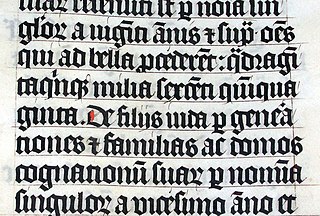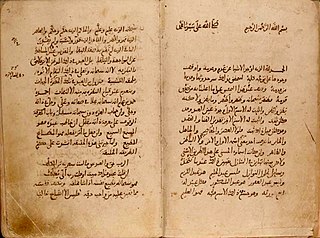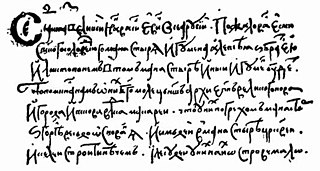Related Research Articles

The Latin alphabet, also known as the Roman alphabet, is the collection of letters originally used by the ancient Romans to write the Latin language. Largely unaltered excepting several letters splitting—i.e. ⟨J⟩ from ⟨I⟩, and ⟨U⟩ from ⟨V⟩—additions such as ⟨W⟩, and extensions such as letters with diacritics, it forms the Latin script that is used to write most languages of modern Europe, Africa, America and Oceania. Its basic modern inventory is standardised as the ISO basic Latin alphabet.
A macron is a diacritical mark: it is a straight bar ¯ placed above a letter, usually a vowel. Its name derives from Ancient Greek μακρόν (makrón) 'long' because it was originally used to mark long or heavy syllables in Greco-Roman metrics. It now more often marks a long vowel. In the International Phonetic Alphabet, the macron is used to indicate a mid-tone; the sign for a long vowel is instead a modified triangular colon ⟨ː⟩.

Shorthand is an abbreviated symbolic writing method that increases speed and brevity of writing as compared to longhand, a more common method of writing a language. The process of writing in shorthand is called stenography, from the Greek stenos (narrow) and graphein. It has also been called brachygraphy, from Greek brachys (short), and tachygraphy, from Greek tachys, depending on whether compression or speed of writing is the goal.

Thorn or þorn is a letter in the Old English, Old Norse, Old Swedish and modern Icelandic alphabets, as well as modern transliterations of the Gothic alphabet, Middle Scots, and some dialects of Middle English. It was also used in medieval Scandinavia but was later replaced with the digraph th, except in Iceland, where it survives. The letter originated from the rune ᚦ in the Elder Futhark and was called thorn in the Anglo-Saxon and thorn or thurs in the Scandinavian rune poems. It is similar in appearance to the archaic Greek letter sho (ϸ), although the two are historically unrelated. The only language in which þ is currently in use is Icelandic.

The long s, ⟨ſ⟩, also known as the medial s or initial s, is an archaic form of the lowercase letter ⟨s⟩, found mostly in works from the late 8th to early 19th centuries. It replaced one or both of the letters s in a double-s sequence. The modern ⟨s⟩ letterform is known as the "short", "terminal", or "round" s. In typography, the long s is known as a type of swash letter, commonly referred to as a "swash s". The long s is the basis of the first half of the grapheme of the German alphabet ligature letter ⟨ß⟩,. As with other letters, the long s may have a variant appearance depending on typeface: ſ, ſ, ſ, ſ.
The tilde is a grapheme ⟨˜⟩ or ⟨~⟩ with a number of uses. The name of the character came into English from Spanish tilde, which in turn came from the Latin titulus, meaning 'title' or 'superscription'. Its primary use is as a diacritic (accent) in combination with a base letter. Its freestanding form is used in modern texts mainly to indicate approximation.

È, è (e-grave) is a letter of the Latin alphabet. In English, è is formed with an addition of a grave accent onto the letter E and is sometimes used in the past tense or past participle forms of verbs in poetic texts to indicate that the final syllable should be pronounced separately. For example, blessèd would indicate the pronunciation BLESS-id rather than BLEST. It also occurs in loanwords such as Italian caffè.
The orthography of the Old Norse language was diverse, being written in both Runic and Latin alphabets, with many spelling conventions, variant letterforms, and unique letters and signs. In modern times, scholars established a standardized spelling for the language. When Old Norse names are used in texts in other languages, modifications to this spelling are often made. In particular, the names of Old Norse mythological figures often have several different spellings.

A prescription, often abbreviated ℞ or Rx, is a formal communication from a physician or other registered healthcare professional to a pharmacist, authorizing them to dispense a specific prescription drug for a specific patient. Historically, it was a physician's instruction to an apothecary listing the materials to be compounded into a treatment—the symbol ℞ comes from the first word of a medieval prescription, Latin recipe, that gave the list of the materials to be compounded.

In writing and typography, a ligature occurs where two or more graphemes or letters are joined to form a single glyph. Examples are the characters ⟨æ⟩ and ⟨œ⟩ used in English and French, in which the letters ⟨a⟩ and ⟨e⟩ are joined for the first ligature and the letters ⟨o⟩ and ⟨e⟩ are joined for the second ligature. For stylistic and legibility reasons, ⟨f⟩ and ⟨i⟩ are often merged to create ⟨fi⟩ ; the same is true of ⟨s⟩ and ⟨t⟩ to create ⟨st⟩. The common ampersand, ⟨&⟩, developed from a ligature in which the handwritten Latin letters ⟨e⟩ and ⟨t⟩ were combined.
In written languages, an ordinal indicator is a character, or group of characters, following a numeral denoting that it is an ordinal number, rather than a cardinal number. Historically these letters were "elevated terminals", that is to say the last few letters of the full word denoting the ordinal form of the number displayed as a superscript. Probably originating with Latin scribes, the character(s) used vary in different languages.

Titlo is an extended diacritic symbol initially used in early Cyrillic and Glagolitic manuscripts, e.g., in Old Church Slavonic and Old East Slavic languages. The word is a borrowing from the Greek τίτλος, "title" and is a cognate of the words tittle and tilde. The titlo still appears in inscriptions on modern icons and in service books printed in Church Slavonic.

The r rotunda ⟨ ꝛ ⟩, "rounded r", is a historical calligraphic variant of the minuscule (lowercase) letter Latin r used in full script-like typefaces, especially blackletters.

Roman cursive is a form of handwriting used in ancient Rome and to some extent into the Middle Ages. It is customarily divided into old cursive and new cursive.

Scribal abbreviations, or sigla, are abbreviations used by ancient and medieval scribes writing in various languages, including Latin, Greek, Old English and Old Norse.

A Christogram is a monogram or combination of letters that forms an abbreviation for the name of Jesus Christ, traditionally used as a religious symbol within the Christian Church.

In Christian scribal practice, nomina sacra is the abbreviation of several frequently occurring divine names or titles, especially in Greek manuscripts of the Bible. A nomen sacrum consists of two or more letters from the original word spanned by an overline.

William Shakespeare's handwriting is known from six surviving signatures, all of which appear on legal documents. It is believed by many scholars that the three pages of the handwritten manuscript of the play Sir Thomas More are also in William Shakespeare's handwriting. This is based on many studies by a number of scholars that considered handwriting, spelling, vocabulary, literary aspects, and more.

An autograph or holograph is a manuscript or document written in its author's or composer's hand. The meaning of "autograph" as a document penned entirely by the author of its content overlaps with that of "holograph".

Skoropis is a type of Cyrillic handwriting that developed from semi-ustav in the second half of the 14th century and was used in particular in offices and private office work, from which a modern handwriting developed in the 19th century.
References
- ↑ Tannenbaum, Samuel A. The Handwriting of the Renaissance (1931), New York: Columbia UP, 125-134.
- ↑ Zurcher, Andrew. "Basic Conventions for Transcription". English Handwriting 1500-1700: An Online Course. University of Cambridge. Retrieved 2018-03-04.
- ↑ Reed, Melania Sánchez (2011). "Transcribing Mediaeval Science for Electronic Editions". In García Ruano, Javier (ed.). Current Trends in Anglophone Studies. Ediciones Universidad de Salamanca. p. 134. ISBN 9788478001576.
- ↑ "Alphabet Abbreviations" (PDF). Practical Paleography. Folger Shakespeare Library.